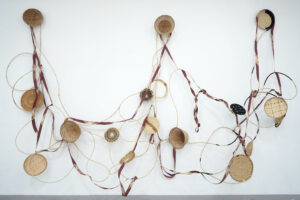
There is no day that I will stand and pretend that I wove the mats or the bags, I mean, that would be a blatant lie but in terms of taking these pieces as additive spices to tell a new story that involves their work, yes, that makes me the artist.
Matt Kayem in conversation with Pamela Elizabeth Acaye Kerunen
Kakare, 2021
Pamela E. Acaye
A Conversation
Pamela Elizabeth Acaye Kerunen is a multi-disciplinary artist with whom curtains have rolled for in theatre while acting, performing poetry and she’s done journalism as well with which she graduated with a Bachelor of Science degree in Mass Communication from the Islamic University in Uganda back in 2009. Vogue Italia Magazine in June 2012 featured her as one of the social activists in Africa to look out for.
But this time, Acaye invades the contemporary art world by mounting an exhibition at the Afriart gallery. Iwang Sawa, the title of the show is drawn from her mother tongue, Alur which stands to mean “in the eye of time”. The work on show is a collaboration between Acaye who takes on the role of artist and curator plus the community weaving artisans who helped her realize her projects. What used to be everyday local crafts items like mats, baskets and woven bags were repurposed into non-functional pieces. The pieces therefore encompass multi-layered narratives, involving aspects of making, heritage, time, meaning, purpose and innovation.
When I saw the exhibition a week ago, I felt compelled to track down the artist/curator for a one on one engagement for she was treading in my ‘waters of interest’- heritage preservation. So, I managed to track down the creative and set up a meeting and on the mid-morning of a Friday which is almost two weeks since the show has been up and we met at the gallery. Our conversation kicked off very fast and we perused through the different layers of the work on show, her background with the arts and the labor and processes behind the work.
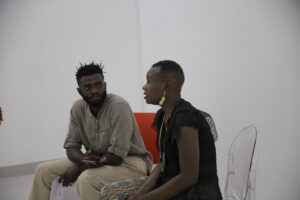
Acaye sits down in a conversation with Matt Kayem.
When I was snooping around on you, I found out that you’ve been pretty much everywhere in the arts. Don’t tell me you’ve also done music like your sister. What’s your attachment to the arts, how do you get to do what you do and occupy the spaces you have?
It’s not that I have done music like my sister but we all do music and we do it differently. Both my mum and dad have been artists and we take granted the things we see growing up. So growing up, my mum is a crotchet artist, while these people weave, my mum would do that with a needle and it will look like that. She does threadwork, not anymore but we grew up seeing her earn from her art. We would see her working on a piece. Either animals in the wilderness, she’s done portraits of Museveni, Fidel Castro. But I have always been drawn to natural fiber but also art by women and growing up, our house, we were always singing where we had a whole choir thing going with mummy, daddy and everyone. So it’s not that I’ve not been doing it before, it’s just the timing and the outside world sees what I allow them to see but there is the lived life that sometimes is very different sometimes from what’s out there, so yah, I’ve been everywhere. And yah, I have one of my songs in production right now. I have about eight pieces of music and has a show in 2018 at Design Hub. I have music that is played in some areas, I’ve written music for theatre when I did my musical in 2006 which was “Dawn of The Proud”, every music within that was written by me, there were a few pieces from my sister.

Installation shot in the gallery, 2021.
So what would you say is your strongest field in the arts?
To be honest, I do not…I allow for the audience to receive and I’ve been lucky that whatever I go into is received well whether it’s writing, poetry, fashion or music, or now installation art. I wouldn’t say there is one best thing, I’m a transitional human being, I evolve everyday depending on the season, I’m good, so don’t be surprised to find me on the stage playing drums and having a hell lot of fun. I dance too and I think we shoot ourselves in the mouth when we start to box ourselves that we are that and this. I’m just a human being, an expressive creative one.
On this project, what do you prefer to go as, artist or curator?
Initially, coming unto the project because it’s a new area and I was having the same conversation with someone else. And I was saying the western construct of a curator organizing things is very linear to me because you cannot pretend to be organizing something without having this innate soul attachment to it. You do what you love and involve yourself in the things you feel most motivated. In that sense the curator came in with organizing the women, going to Masaka, Kyotera, Mukono, meeting them, hearing their stories. But also seeing through what I want out of them, the quality of work that’s coming out and everything. Initially the work was supposed to be done as overseen by me but initially due to covid, mobility became difficult even money.

Ouganda, 2021.
Did you take part in the making of the works on the walls?
I coomissioned all the work and then here and there I gave design instructions like dyes and everythings, so what I did here was take them apart and restructured but the base work I didn’t do it. The waving was done by other people. The time when I came into play was installing them as singular art pieces, stitching them, altering others and deconstructing them.
So you just paid people to work for you?
No, they were not ready to work for me in that sense because they thought I was wasting their time, that I was just playing games putting together things in a fashion they were not used to.
There is always been this contention on the contemporary art scene, of artists who employ assistants to help them make their works which end up becoming the artists’. What’s your take on this seeing that you are using the same method?
There is nothing like an artist being a solo artist. Even a painter is relying on colors or paints that have been made by an artist and commercialized. The brushes and canvas are all made by someone else. All they are doing is adding their story unto this tapestry and that’s where I see myself. There is no day that I will stand and pretend that I wove the mats or the bags, I mean, that would be a blatant lie but in terms of taking these pieces as additive spices to tell a new story that involves their work, yes, that makes me the artist.
So, you are like a director in a movie working with so many artists, actors just waving his hand to tell them what to do or a conductor…
That is quite different because it goes into curatorial as well because the story is already there. And in this case, I have been working with the story of women as artisans, so their story is there and multi-dimensional, multi-layered and all. But because of that, it’s also not very visible so what I do is take it, repurpose it, rearticulate it according to what I give, the meaning I ascribe to it as a contemporary artist caught in this cultural space. So, it’s a story that, yes is mine but it embodies all these other people who’ve been part of the making, so in that sense, I cannot call it a singular story. That’s why I’m very quick to tell you that I’m purposely working with these women
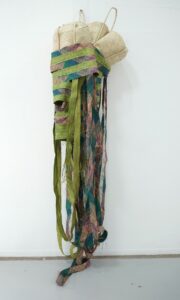
Bamutenda, 2021.
Is the employment of women to realize this project of any core significance to you or the work?
The beauty about these women is that they were already doing this as their subsistence side. These women are depending on 14 to 56 dollars a month coming out of weaving which is done within their time alongside other domestic tasks. She first goes to the garden to dig, comes back to cook, bathe the kids and she sits down to weave which is how she rests from the hectic tasks. So, in terms of a specific employment structure like a 9 to 5 like in western culture is not going to work. And that’s the other challenge I faced, no single one of them was willing to take off even a week to say that she will come to Kampala to sit in somebody’s house and do what they want, they declined. And yet I went there thinking I’m giving them money but they didn’t want it.
A lot of conversations do spring up after a thorough engagement with your work. For example, I think about sustainability and environmental preservation, the idea that our great-grands were intentional or unconsciously in touch with nature, making these ephemeral objects meant to rot away in the ground after use. What was the core idea and concept running in your head when you were doing this work that you want to put at the forefront?
Climate change is real guys and planet earth is all that we’ve got. We have to be very earth conscious and mindful about how we relate to it. Now from time immemorial, women have been the gatekeepers especially in this case of wetlands where a lot of the raw materials come from and these are being encroached on due to commercialization and everything. But if we are to refocus our attention to every single artwork that does not include a single non-natural product, we realize that the planet is enough to feed us, all we need to do is relate to it with the same dignity and respect. So yah. Preservation of the environment is very huge on my agenda but also the idea of women in these endangered environmental spaces. Women are being written out of the artistic story of Uganda, we hear about masters, so and so painted this picture. But the core of the Ugandan population are these women who we don’t even know their names.
So the title “Iwang Sawa”…
Iwang in Alur means ‘you’re burning’ and then sawa is sawa as it is. So it has duo meaning, it’s “to be caught in the eye of time” like the black spot which marks time in your eye or to be caught at the crossroads of time. It’s also burning time for example, for lots of these women when I was with them, the euphemism that kept coming was that ‘you are wasting time’, you are burning up useful time doing these things in a different way. This is an age-old tradition passed down from generation to generation. And also, the amount of time or duration it takes to make which is also very important. Every piece in the exhibition has an element of time, time spent ritualistically knotting, weaving, sewing and everything, which should be celebrated because many times, we take time for, granted. You come and see the finished product and you dismiss it, for example, for me, it’s close to two years to bring out this work. If you have a lazy eye, you won’t see it.
Sheila Nakitende, Fred Kato Mutebi and Xenson are some of the Ugandan artists whose work employs indigenous traditional knowledge and hints on its preservation. Some of the others think that we should leave the past and embrace the present. Do you think it’s important for artists to keep the memories of our ancestors alive in their works?
I don’t speak for artists but I think it’s important that artists honor themselves, because I am honoring yourself, you honor your lineage, your home, your community. So, for me to stand there and say you must do this kind of work is to censor. If turns out that they are doing that and that’s where they would love to go, thank you, but I wouldn’t come out and tell how they should do their art.
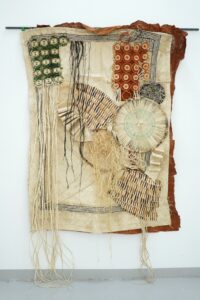
Banange, 2021.
Since you’ve worked in the different sectors of the arts, namely; theatre/drama, film (have you?), poetry, maybe music. What or where do you think the contemporary art scene in Uganda should work on that the others might be getting right?
That’s a big question, I think, personally, I’m just doing me, I’m unapologetic about my work. I could have easily listened to the things in my head about where I will put these mats and baskets but look where it has gotten me. Stay true because challenges will always come, censorship will always come but the only thing that remains is our voice and touch and if these are authentic.
When I look at this work, it’s one of those that has caught my eye for of all because of its title which is a popular Luganda word. What were you thinking when you created ‘Banange’?
My goal in this work was to celebrate the different weaving styles and patterns from central Uganda and also to deconstruct, for instance, the rings on there used to be bags. These bags were used by Mother’s Union people to carry in their bibles. So, I get them because they are beautiful things in the workmanship which I take apart and include them as tapestries or appendages to this. Then there is the mat and the different colors of the mat and the rope, which is very utilitarian in our culture. And I also deconstruct the mat to give a different texture, you know it’s always laid out to look smart. Then I commissioned these rings and told them to scale them up beyond what they are normally used to. So, for me, it’s to reaffirm the other bits of weaving we usually ignore.
And I notice you are using mostly two languages in naming your artworks which are in Alur and Luganda and maybe just one piece is in Swahili.
Swahili was a household language when we grew up because I was born just after my parents had returned from exile in Nairobi so my elder sisters and brothers had been going to Nairobi schools speaking Swahili. Therefore, in that sense, our household was full of Swahili, English and Alur. I love Swahili as a language and have so many Swahili friends. For Luganda, this has been work that I have been doing amongst a lot of central Uganda and with women who primarily speak Luganda. Sometimes you find yourself having to improve your Luganda skills because you have to speak to them. And some words just stand out especially in relation to the work and sometimes it’s meaning that is, for example ayera which is ‘the chosen pieces’ in Alur. To me, it also looks like intestines or offals. But offals in Alur culture are a choice because when they slaughter a cow, the entire organs inside are given to the in-laws without being taken apart. Now the in-laws clean them out and make this amazing stew out of them that is called ayera that is usually served to in-laws at funerals, weddings. It is like this choice meal that they serve and these mat pieces were some of the bests I looked at when I went, very beautifully done, colors are striking, they looked really good. And then for the brown and green, I commissioned those colors, that’s why you see there are thinner and I was playing with the idea in my mind, how much more buoyant, flexible or tactile can I make this. That piece for the women, is me misusing the materials. And I was thinking of a necklace, an adornment.
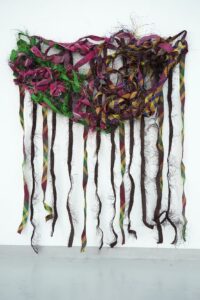
Ayera, 2021.
What’s the future of Pamela Acaye?
I’m just going to be doing me, you can expect a lot of work from me, don’t get used to the idea of Acaye being a singular artist because tomorrow I will invite you to my fashion showcase. I think the day I stop creating and bringing something new, know that I’m dead.
